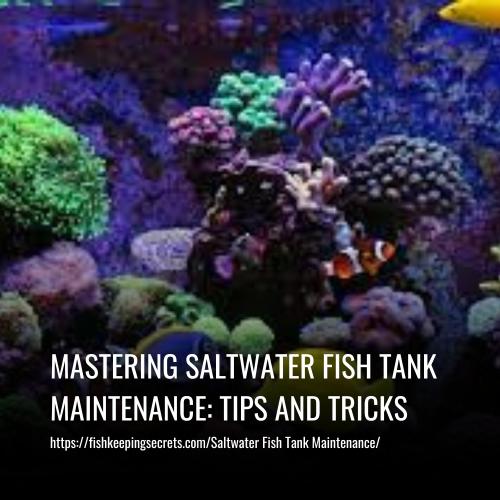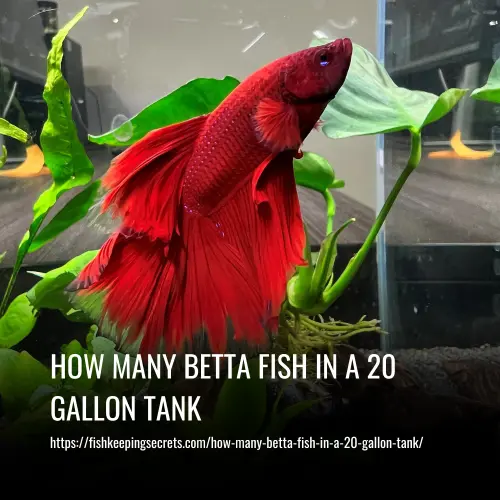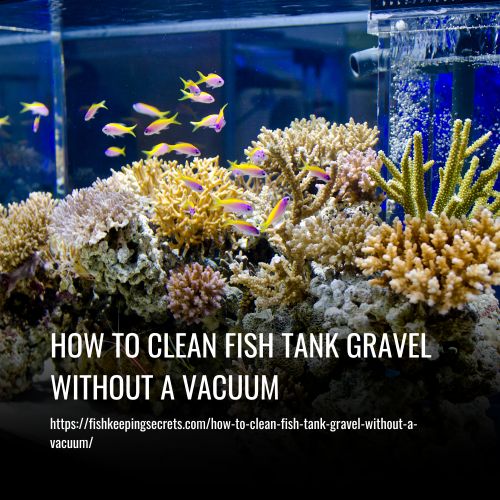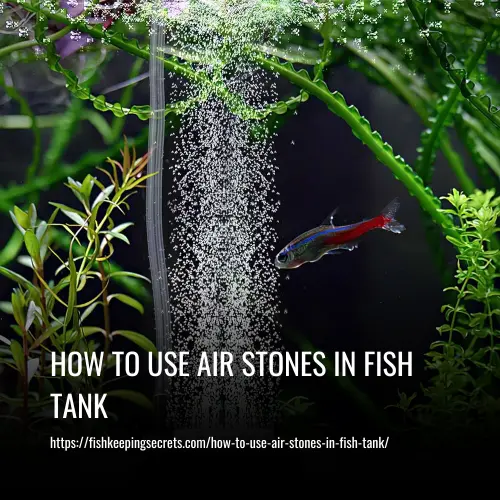Maintaining a saltwater fish tank can be challenging due to its delicate balance and specific requirements. In this article, we will discuss the intricacies of managing a saltwater aquarium and provide tips on how to keep it healthy and thriving.
Keeping a saltwater fish tank is a rewarding hobby that requires dedication and attention to detail. With proper care and maintenance, you can create a beautiful underwater world for your fish, corals, and other marine creatures to thrive in. However, without the right knowledge and preparation, it can quickly become overwhelming and frustrating.
In the following sections, we will explore the essential elements of saltwater aquarium maintenance, including filtering, water chemistry, and feeding.

Setting Up The Saltwater Fish Tank
Before starting your saltwater fish tank, it is crucial to properly set it up to create the ideal conditions for your marine life. Here are some steps to follow:
1. Choosing The Right Tank Size And Shape:
One of the most crucial decisions to make when setting up a saltwater fish tank is selecting the right size and shape. Here are some key points to keep in mind:
- Consider the types and number of fish you’d like to keep. Larger and more active fish require bigger tanks.
- Calculate the water volume needed for your chosen fish species, including enough space for them to swim comfortably.
- Don’t forget to factor in the size of additional equipment you’ll need to install.
- Tanks come in various shapes, such as rectangular, cylindrical, and bow-front. Think about which one best suits the room you’ll be keeping it in and your aesthetic preference.
- Keep in mind that larger tanks are generally easier to maintain as they provide more stable water conditions.
2. Selecting Appropriate Substrates And Decorations:
The substrates and decorations you choose for your saltwater fish tank not only add to the aesthetic appeal but also serve functional purposes such as providing hiding spots and creating a natural habitat for the fish. Here’s what you should consider:
- Choose substrates that are suitable for your chosen fish species. Live sand and live rock are popular choices and can help establish a healthy biological filter.
- Avoid using decorations or substrates that could be harmful to fish, such as sharp or toxic materials.
- Consider adding some artificial or live plants to provide hiding spots and a more natural environment.
- Think about the colors and themes you’d like to incorporate, but keep it simple and avoid overdecorating, which can lead to poor water circulation and accumulation of debris.
3. Installing Essential Equipment:
Installing the right equipment is crucial to maintain a healthy saltwater fish tank. Here are some essential pieces of equipment you need to consider installing:
- Filters to remove debris, chemicals, and toxins from the water.
- Protein skimmers to remove organic wastes and prevent the water from becoming cloudy.
- Heaters to maintain stable water temperatures, usually between 74-78°f (23-26°c) for most saltwater fish.
- Lighting systems to aid photosynthesis in live plants and create a day/night cycle for fish.
- Powerheads or circulation pumps to stimulate water movement and prevent stagnation.
- A thermometer to monitor water temperatures.
4. Adding Essential Elements And Maintaining The Right Salinity Level:
Once your tank is set up and equipped, you must add essential elements such as salt mix to achieve the right salinity level, essential for the survival of saltwater fish. Here are some key pointers:
- Follow the instructions on the salt mix to achieve the recommended salinity level, usually 1.020-1.025 specific gravity.
- Maintain the correct salinity level by regular monitoring with a hydrometer or refractometer.
- Regularly test the water for other essential parameters such as ph, ammonia, nitrites, and nitrates.
- Make partial water changes of 10-15% every two weeks to maintain water quality and replenish essential elements that become depleted over time.
Setting up and maintaining a saltwater fish tank may seem daunting, but by following these guidelines, you can enjoy the beauty and tranquility of your very own underwater world.
Regular Saltwater Fish Tank Tasks
Maintaining a saltwater fish tank requires regular maintenance tasks to keep its inhabitants healthy and happy. Here are the essential tasks you should include in your regular maintenance routine:
1. Changing Water Frequently And Properly:
- Experts recommend changing 10-15% of the tank’s water every two weeks, and up to 25% every month, depending on the tank’s size and stocking levels.
- When changing water, make sure to follow the proper procedure to maintain the tank’s salinity and temperature.
- Use a good-quality dechlorinator to remove chlorine and other harmful chemicals before refilling the tank.
2. Maintaining Healthy Ph Levels:
- Saltwater fish and marine plants thrive in a stable ph range of 8.1-8.4.
- Test your tank’s ph level regularly and adjust it accordingly by adding buffers or other ph stabilizers as needed.
- Avoid quick and drastic ph changes in the tank, as these can lead to stress and other health issues for your fish and plants.
3. Maintaining Proper Lighting Conditions For Plant Growth And Fish Health:
- Choose the right lighting system based on the type of plants and fish you have in your tank.
- Provide the right amount of light for each species, ensuring they get enough but not too much.
- Adjust the lighting duration according to the plants’ needs to support proper photosynthesis and to promote fish health and activity.
4. Checking On And Treating Fish For Any Diseases Regularly:
- Inspect your fish and plants regularly for signs of illness, such as a decrease in appetite, lethargy, or abnormal behavior.
- Quarantine any sick fish in a separate tank and treat them using the appropriate medication to prevent the spread of diseases.
- Maintain a healthy and stress-free environment in your tank by ensuring proper water quality, feeding your fish a balanced diet, and avoiding overcrowding.
By following these regular maintenance tasks, you can keep your saltwater fish tank healthy and beautiful, providing a peaceful and serene environment for you to enjoy.
Preventing Common Problems
Maintaining a saltwater fish tank requires proactive measures to prevent common problems. Here are some tips to help you avoid issues that can negatively impact your tank:
Preventing Algal Blooms Through Proper Maintenance And Lighting
Algal blooms can cause serious issues in your saltwater fish tank. It can lead to oxygen depletion and poor water quality. Here are some tips on preventing algal blooms.
- Regular water changes: Frequent water changes can help reduce nutrient buildup, which can contribute to the growth of algae.
- Proper lighting: Make sure you are using the correct lighting for your tank size and type of corals. Too much light can create an ideal environment for algae growth.
- Regular cleaning: Keep your tank clean by removing any debris, uneaten food, and dead organisms.
- Algae eaters: Consider adding algae eaters like snails, hermit crabs, and some fish species that can help control the growth of algae.
Preventing Ammonia Spikes Through Regular Water Changes And Testing
Ammonia buildup can quickly become dangerous for your fish, causing stress and even death. Here are some tips on how to prevent ammonia spikes.
- Regular water changes: Ammonia spike is usually due to a buildup of organic waste. Regular water changes can help remove it and keep the levels under control.
- Testing: Get an ammonia testing kit and test your water regularly to ensure that the levels remain safe for your fish.
- Proper feeding: Overfeeding your fish can lead to excess organic matter, which can contribute to ammonia buildup. Make sure you’re feeding the correct amount of food on a regular schedule.
Preventing Fish Stress Through Proper Care And Feeding
Fish, like all animals, can get stressed. Stress can lead to sickness and death. Here are some tips on how to reduce fish stress.
- Proper care: Make sure your tank is appropriately sized, properly filtered, and that water conditions are maintained.
- Proper feeding: Feed your fish a balanced diet and on a consistent schedule. Overfeeding can induce stress, so make sure to limit the amount of food you give them.
- Provide hiding spots: Fish like to have a place to hide in their tank. Consider adding some decorations or other hiding spots to reduce stress.
Remember that proper maintenance is the key to a healthy saltwater aquarium. Following the tips above can help prevent common problems and keep your fish happy and healthy.
Troubleshooting Common Problems
Maintaining a saltwater fish tank is no easy feat, and even the most experienced aquarists encounter problems from time to time. Troubleshooting common problems is an essential aspect of keeping your tank running smoothly. Here are some tips for identifying and treating common fish diseases, restoring proper water quality, and addressing and preventing algae outbreaks.
Identifying And Treating Common Fish Diseases
Whether you’re a beginner or a seasoned professional, identifying and treating common fish diseases is crucial in maintaining a healthy saltwater aquarium. A few common diseases include:
- Ich or white spot disease: This parasitic infection presents as white spots on the fish’s body or fins. An increased respiratory rate or the fish scratching against objects is also a sign of this disease. Treatment options include medicated baths or copper-based medications.
- Fin rot: This bacterial infection causes the fins and tail to deteriorate. Poor water quality, stress, and injuries can cause fin rot. Treatment options include water changes, antibiotics, or a combination of both.
- Velvet disease: This parasitic infection appears as a dusty or velvet-like substance on the fish’s body or fins. Fish may also exhibit lethargy, loss of appetite, and rapid breathing. Treatment options include medicated baths or copper-based medications.
Restoring Proper Water Quality After Issues Such As Cloudy Water Or Ph Imbalances
Poor water quality can lead to numerous issues in a saltwater fish tank, including cloudy water and ph imbalances. Here are a few tips for restoring proper water quality:
- Cloudy water: This can be the result of many factors, such as overfeeding or inadequate filtration. The most effective way to manage cloudy water is by doing partial water changes, deep cleaning the tank’s substrate and decorations, and improving the filtration system.
- Ph imbalances: An unbalanced pH level can affect the health of your fish and cause sudden deaths. A ph of 8.2 is ideal for most saltwater fish. If the pH level is too low or high, try adding pH buffers or doing partial water changes to restore it.
Tips For Addressing And Preventing Algae Outbreaks
Algae outbreaks are a common headache for most aquarium owners. Algae growth depends on multiple factors, including lighting, nutrient levels, and water quality. Here are a few tips for addressing and preventing algae outbreaks:
- Keep your lighting on a timer and avoid prolonged exposure to sunlight.
- Reduce nutrient levels in the water by avoiding overfeeding and performing regular water changes.
- Introduce algae-eating critters, such as snails and hermit crabs.
- Use specialized filters or protein skimmers to remove excess nutrients from the water.
By troubleshooting common problems and following these tips, maintaining a saltwater fish tank can be a rewarding and enjoyable hobby. Remember to monitor your tank regularly to prevent issues and ensure the health and wellbeing of your fish.
FAQs
It is recommended to change 10% to 20% of the water in a saltwater fish tank every two weeks. This helps maintain water quality and prevent the build-up of harmful chemicals and waste.
Maintaining a saltwater fish tank can be challenging, requiring a lot of time and effort. Consistency and attention to detail are key factors in keeping the tank healthy and the fish thriving.
A heater and a chiller can be used to regulate the temperature in a saltwater fish tank. A heater is used to keep the water warm, while a chiller is used to cool it down. It is important to use a thermometer to monitor the temperature regularly.
While saltwater fish tanks are more challenging to maintain than freshwater tanks, beginners can learn how to manage them with time and patience. Starting with a smaller tank can be less overwhelming and help you gain experience before moving on to a larger setup.
It is important to regularly test the salinity level in a saltwater fish tank using a hydrometer. To maintain the correct level, a mix of saltwater and freshwater can be added. It is important to be aware of the salinity level changes caused by evaporation and replace the water to avoid fluctuations.
Conclusion
Ultimately, maintaining a saltwater fish tank is not an easy task. It requires dedicated effort, attention to detail, and careful maintenance. However, with the right knowledge and approach, it can be a rewarding and fulfilling experience. Before getting started, it’s important to do your research and learn as much as you can about the specific needs of the fish and the equipment required.
You’ll also need to stay vigilant and keep a close eye on your tank’s water chemistry, temperature and overall health. But if you’re committed to putting in the work and giving your fish a healthy and thriving environment, the results can be truly magical.



